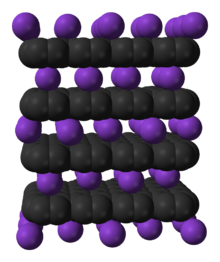Graphite intercalation compound


Graphite intercalation compounds are complex materials having formula XCy where element or molecule X is inserted (intercalated) between the graphite layers.[1][2][3][4]. In this type of compound the graphite layers remain largely intact and the guest molecules or atoms are located in between. When the host (graphite) and the guest X interact by charge transfer the in-plane electrical conductivity generally increases. When the guest forms covalent bonds with the graphite layers as in fluorides or oxides the conductivity decreases as the conjugated sp² system collapses.
General structure
In a graphite intercalation compound not every layer is necessarily occupied by guests. In so-called stage 1 compounds graphite layers and intercalated layers alternate and in stage 2 compounds two graphite layers with no guest material in between alternate with an intercalated layer. The actual composition may vary and therefore these compounds are an example of non-stoichiometric compounds. It is customary to specify the composition together with the stage.
At the first stage, binary graphite-metal intercalation have stoichiometry XC8 for the large metals (X = K, Rb and Cs) and XC6 for small ones (X = Li, Sr, Ba, Eu, Yb and Ca).[2]
Calcium graphite
Bulk samples of calcium graphite CaC6 are obtained by immersing highly oriented pyrolytic graphite in a well-chosen liquid Li–Ca alloy for long time (10 days at 350 °C). The crystal structure of CaC6 belongs to the R¯3m space group. The graphite interlayer distance increases upon Ca intercalation from 3.35 to 4.524 Å, and the carbon-carbon distance increases from 1.42 to 1.444 Å. Among the superconducting graphite intercalation compounds, CaC6 exhibits the highest critical temperature Tc = 11.5 K, which further increases under applied pressure (15.1 K at 8 GPa)[2]
Potassium graphite
The KC8 form of potassium graphite is one of the strongest reducing agents known. It is prepared under inert atmosphere by melting potassium over graphite powder. The potassium is absorbed into the graphite and its color changes from black to bronze. The resulting solid is also quite pyrophoric. Structurally, composition can be explained by assuming that the potassium to potassium distance is twice the distance between hexagons in the carbon framework. The bond between graphite and potassium atoms is ionic and the compound is electrically conductive. [5] KC8 is a superconductor with a very low critical temperature Tc = 0.14K.[2] It has also been used as a catalyst in polymerizations and as a coupling reagent for aryl halides to biphenyls [6]. In one study [6] freshly prepared KC8 was treated with 1-iodododecane delivering a modification (micrometre scale carbon platelets with long alkyl chains sticking out providing solubility) that is soluble in chloroform. Another potassium graphite compound, KC24, has been used as a neutron monochromator.
Carbon fluorides
Carbon monofluoride is denoted as (CF)x and used as a cathode material in a type of lithium batteries. It is prepared by reaction of gaseous fluorine with graphitic carbon at 215-230 °C. The color is grayish, white, or yellow. The bond between the carbon and fluorine atoms is covalent. The compound is not electrically conductive.
Tetracarbon monofluoride (C4F) is prepared by reacting gaseous fluorine mixed with hydrogen fluoride with graphite at room temperature. The compound has blackish-blue color.
Others
Other graphite intercalation compounds are graphite bisulfate and graphite oxide. Examples of complex graphite intercalation compounds are those with barium and ammonia guests (Ba(NH3)2.5C10.9(st.1)) or those with caesium, hydrogen and potassium (CsC8.K2H4/3C8(st.1)).
References
- ^ M.S. Dresselhaus and G. Dresselhaus Review: "Intercalation compounds of graphite" Advances in Physics 30 (1981) 139 (187 pages), also reprinted as Advances in Physics 51 (2002) 1
- ^ a b c d N. Emery et al. Review: "Synthesis and superconducting properties of CaC6" Sci. Technol. Adv. Mater. 9 (2008) 044102 free download
- ^ H-P Boehm et al. "Nomenclature and terminology of graphite intercalation compounds" Pure & Appl. Chem. 66 (1994) 1893 free download
- ^ D. Savoia et al. "Applications of potassium-graphite and metals dispersed on graphite in organic synthesis" Pure & Appl. Chem. 57 (1985) 1887 free download
- ^ NIST Ionizing Radiation Division 2001 - Technical Highlights
- ^ a b S. Chakraborty et al. "Functionalization of Potassium Graphite" Angew. Chem. Int. Ed. 46 (2007) 4486
